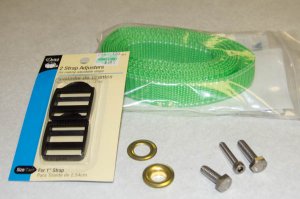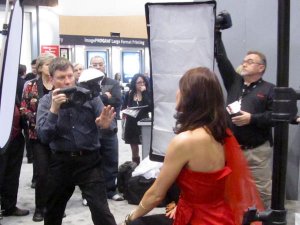Online Magazine
Recent Posts
- Safeguard your Cellphone Photos
- Black & White to Color – Instantly
- Wearing Many Hats
- Video Roundup
- Rescuing Your Blurry Pictures
- Showing Their Age
- What is Your Angle?
- Panorama Photos
- Humorous Photos
- Close Ups
- Fisheye Pictures
- Photo Antiquities
- Printing Big
- Appreciating Scale
- Celebrity Sightings
Tags
More Places to Go
- Free "How-To" Books “How To” books for popular cameras 0
- Vist Us on Facebook keep in touch with us on Facebook 2
Archives
- July 2023 (1)
- March 2023 (2)
- February 2023 (1)
- December 2022 (1)
- October 2022 (1)
- September 2022 (8)
- August 2022 (9)
- July 2022 (1)
- June 2022 (1)
- June 2021 (1)
- May 2021 (1)
- March 2021 (5)
- February 2021 (4)
- January 2021 (2)
- April 2019 (1)
- March 2019 (1)
- February 2019 (1)
- October 2018 (2)
- April 2018 (1)
- March 2018 (4)
- February 2018 (1)
- November 2017 (1)
- August 2017 (1)
- June 2017 (1)
- April 2017 (1)
- March 2017 (5)
- February 2017 (2)
- January 2017 (1)
- October 2016 (1)
- September 2016 (1)
- August 2016 (1)
- July 2016 (1)
- May 2016 (1)
- April 2016 (1)
- March 2016 (2)
- February 2016 (1)
- January 2016 (2)
- December 2015 (1)
- November 2015 (1)
- October 2015 (3)
- April 2015 (1)
- March 2015 (5)
- February 2015 (1)
- January 2015 (4)
- December 2014 (2)
- November 2014 (5)
- October 2014 (2)
- September 2014 (1)
- August 2014 (2)
- July 2014 (1)
- May 2014 (1)
- April 2014 (5)
- March 2014 (5)
- December 2013 (2)
- November 2013 (18)
- October 2013 (1)
- September 2013 (1)
- August 2013 (1)
- July 2013 (1)
- June 2013 (3)
- May 2013 (1)
- April 2013 (2)
- March 2013 (1)
- February 2013 (1)
- January 2013 (1)
- December 2012 (1)
- November 2012 (2)
- October 2012 (2)
- September 2012 (5)
- August 2012 (2)
- July 2012 (1)
- June 2012 (1)
- May 2012 (1)
- April 2012 (4)
- March 2012 (1)
- February 2012 (1)
- January 2012 (3)
- December 2011 (1)
- November 2011 (3)
- October 2011 (1)
- September 2011 (2)
- August 2011 (2)
- June 2011 (3)
- May 2011 (4)
- April 2011 (8)
- March 2011 (8)
- February 2011 (10)
- January 2011 (6)
- December 2010 (11)
- November 2010 (14)
- October 2010 (6)
- September 2010 (12)
- August 2010 (2)
- July 2010 (4)
- June 2010 (3)
- May 2010 (1)
- April 2010 (1)
- March 2010 (2)
- February 2010 (1)
- January 2010 (1)
- December 2009 (1)
- November 2009 (2)
- October 2009 (2)
- September 2009 (1)
- August 2009 (3)
- July 2009 (2)
- June 2009 (1)
- May 2009 (2)
- April 2009 (1)
- March 2009 (2)
- February 2009 (1)
- January 2009 (3)
A very portable “tripod”
28th February 2011
Make yourself a simple “strap tripod”
Owing to various photo assignments, I seem to spend a considerable of time in the field. But I’ll have to admit that I’m not a big fan of lugging around a tripod. My “excuse” is that with all of the shuttling back and forth, a tripod is not the easiest item to carry-on when traveling by airplane.
There are many times however, that I could use the rock-steady support of a tripod. For these occasions, I make do with a substitute accessory that easily stores in my pocket or backpack.
As you’ll see, this accessory is not very sophisticated, but it does an adequate job of squeezing two or three additional stops of exposure from my camera when the light is fading.
Walking Around WPPI – Part 3
26th February 2011
Wedding & Portrait Photographers International Convention – Part 3

Last Wednesday was the last day of the WPPI Trade Show and I again walked the aisles to take it all in.
Most of the attendees are at WPPI to learn techniques that they can harness for their wedding and portrait photography businesses. To promote their products, companies provide floor demonstrations that show ways that their products are used.
| One of the largest group exhibitors were the photofinishers. The competition was less based on price and more based on selection and customer service.
As you can see by the exhibits, there is a tremendous selection of size, finishes, variations and mountings. Albums, postcards, posters, t-shirts, more…. |
|
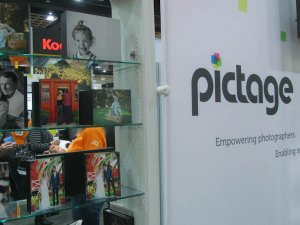 |
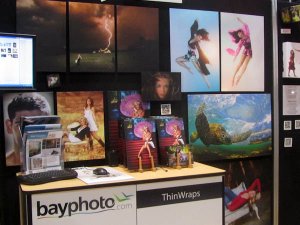 |
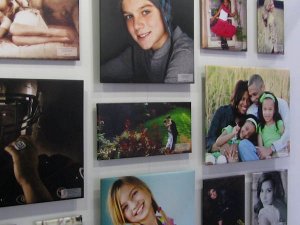 |
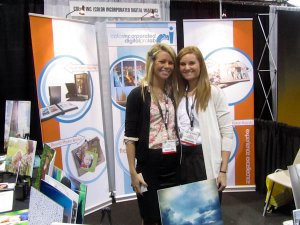 |
| Shootsac makes camera accessory bags that don’t look like camera accessory bags. Designed with the female photographer in mind, they’re both practical and fashionable. | 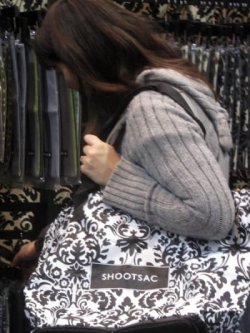 |
| Triple Scoop Music is in the business of licensing music. They have a large library of more than 7000 songs.
Photographers that want to use music for slideshows and/or videos can license any of these songs which can then be used royalty-free. Having licensed music in the past, I am convinced that having a single point of contact makes for a hassle-free way to add music to your productions. For more information contact Triple Scoop Music. |
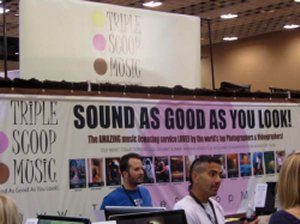 |
| Having heard about Fuji‘s 3D camera, I stopped by their booth for a demo.
The Fuji W3 camera is an advanced point-and-shoot with two lenses. When you snap a photo, the two images are combined to form a single “.mpo” file which you can immediately view on the specially designed 3-1/2″ LCD without using glasses. Plug your camera into a 3D television, pop on a set of glasses and you’ll see amazing 3D effect of this camera. Below is an example. When viewed, I was able to see the 3D effect of my outstretched hand. This stuff is cool. For more information see Fuji |
|
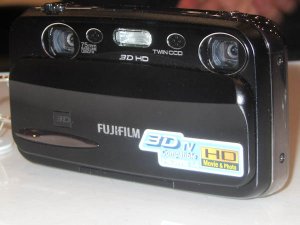 |
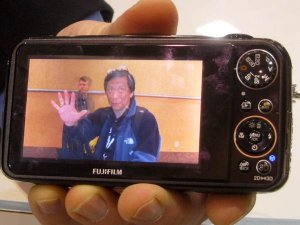 |
As a frequent trade show goer, I’m sometimes blasé about walking up and down aisles. But this week, I could sense real excitement from both exhibitors and attendees. I too came away excited about the WPPI show.
This trade show is mainly about small businesses – photographers seeking the know-how to profit from their skills. They want to stay ready for the opportunities that arise as the economy recovers. I’m heartened to share the energy.
As an aside, I am a frequent visitor to the Las Vegas trade shows – 2 to 4 a year for the past 30 years. From my un-scientific measure, it’s been 4 years since I’ve seen Las Vegas as busy as this week. With concurrent conventions taking place the hotels, casinos and restaurants were filled. I’m hoping that this is a sign that things are looking up for economic growth all over.
Written by Arnie Lee
Accessories From Hoodman USA
26th February 2011
Help Seeing with your DSLR
These two accessories look simple because, well, they are simple. They’re also those types of accessories you might not think about using until you do and then you wonder why you went so long without them.
The first is the HoodEYE eyepiece from Hoodman. The HoodEYE, which replaces the normal eyepiece of your Nikon or Canon DSLR camera, helps block out light from the side that might reduce your ability to see correctly in the viewfinder. All you need to do is gently slide off the normal eyepiece and slide the HoodEYE on the mounting rails. It takes only a few seconds. You can rotate the HoodEYE eyecup left or right to accommodate both “right-eyed” photographers and “left-eyed” photographers. It won’t cover or interfere with the LCD screen.
Click the following to view a video of the HoodEYE.
I used it with my Canon XTi and it worked as I hoped. I was outdoors on a bright sunny day with the added problem of sunlight reflecting off the snow but everything in the viewfinder was bright and clear. Best of all, I didn’t have to hold my left hand around my eye to frame the picture and read the display in the viewfinder while trying to hold the camera steady with the my right hand.
(more…)
